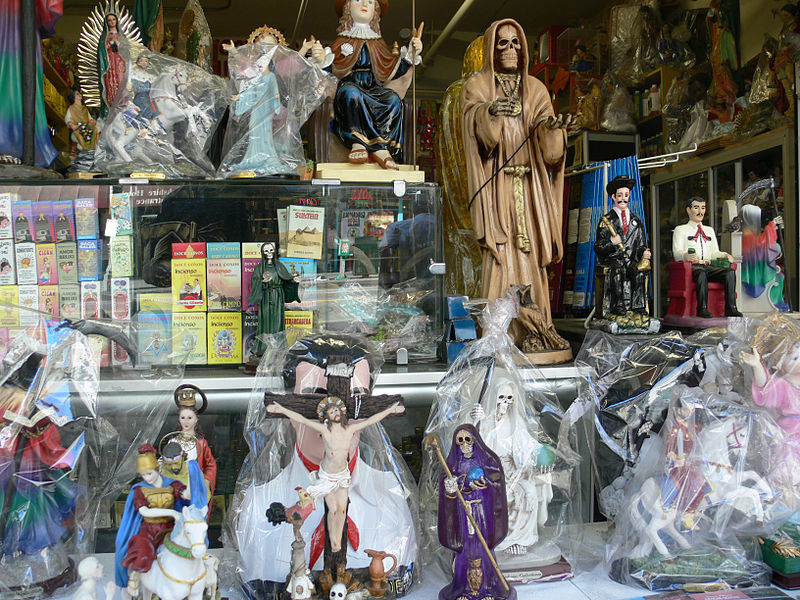
Image@Wikipedia
La Santa Muerte and Malverde are everywhere in San Cristóbal de Las Casas and in Chiapas cities like Teopisca. Their cult is not hidden. The markets are full of ritual objects typical for their veneration. The herbal and magic shops of the old Jovel now have monumental Huesudas and Malverdes welcoming the faithful.
On April 17th, Jerónimo Ruiz, leader of the Association of Traditional Market Tenants of Chiapas (ALMETRACH), was shot dead by two men on a motorcycle. In the midst of chaos and panic, violence broke out in the north of the old capital. Two armed groups blocked streets and clashed and set fire to tires and houses. Among other lucrative activities, ALMETRACH collects rents from artisans.
Jerónimo was from a community near Betania/Teopisca ironically called Flores Magón. At the altar to the Niña Blanca that the deceased had in his house, there was an oath to avenge his death.
Two days after the crime, a recording warned: “San Cristóbal and its surroundings, as you already noticed, we have already entered and the cleanup has already begun, we are the Jalisco Cartel and what happened to Jerónimo Ruiz is going to happen to Narciso Ruiz, alias El Narso, Calafas, Águila, Birria, Max and all those groups of motonetos that are supporting these scourges.”
Chiapas is a place where the most diverse denominations flourish. Traditional churches coexist with expressions of popular religion. The veneration of the Santísima Muerte has grown exponentially hand in hand with the growth of organized crime, but also due to other causes completely unrelated to it, such as faith healing. Not all of its faithful are dedicated to illegal activities, but frequently, in a kind of syncretism, many of those who dedicate themselves to them find in the fervor of this religiosity the path to get closer to the sacred.
Teopisca, 30 kilometers from San Cristóbal, is a key route for undocumented migrants and drugs. In June 2022, armed individuals shot and killed the mayor, Rubén de Jesús Valdez Díaz, of the Green Ecologist Party of Mexico (PVEM), as he was leaving his house. The hitmen were allegedly hired from Jovel’s motonetos.
The murder is part of the conflict over the municipality between two groups. Those of Betania, whose visible head is Javier Velázquez Díaz, alias La Pulga (now under arrest), and those of the local group of former municipal president Luis Alberto Valdez Díaz, accused of robbing the municipality when he was mayor and brother of the murdered mayor. Local rumors point to him as the alleged mastermind of the fratricide.
Both gangs are related to the trafficking of migrants (polleros) and the production and distribution of drugs. Those from Betania have laboratories in their deeply evangelical community.
The cult of La Huesuda and Malverde proliferates in the town. Large processions are held and there is more and more devotion to them. As part of the northernization of popular culture, narcocorridos proliferate. The groups raise up the humblest youth. They walk around town with high caliber weapons and bulletproof vests with impunity. It is common to hear shots fired into the air.
One faction wants to form the Teopisca municipal council. However, beyond the supposedly democratic demands, its promoters are also narco-polleros, who seek to convince the communities by financing religious festivals. At the same time, they promise to build roads to the lowlands of the municipality, the central depression of Chiapas adjacent to the municipality of Venustiano Carranza, a key route for transporting drugs and undocumented immigrants.
According to residents of the municipality, the group of former municipal president Luis Valdez would be linked to Sinaloa, while those of Betania with La Pulga would be part of the Sinaloa cartel. They say that those from the Pacific (Sinaloa), who have been in the region longer, go about their business and don´t bother people, but those from Jalisco extort, kidnap, charge protection money, etc. From their point of view, those from Sinaloa go for convenience, depending on the business in question and are easygoing, if you don’t mess with them. But the New Generation are bad people.
What is happening in San Cristóbal and Teopisca is just a sample of what is happening throughout Chiapas. It is not the exception, but the rule. It is part of a much larger plot. It is unimaginable to suppose that the activities of these narco-polleros are unknown to the regional power networks and those responsible for keeping order.
The Zapatista communities do not allow the planting, production or traffic of drugs. Their routes are closed to human traffickers. They do not take sides in disputes between cartels for control of markets and territories. They are a brake on the expansion of the criminal industry and on the business of authorities linked to them. With their experience of self-government and self management, among many reasons, war has been declared on them. Also, due to this, old and new paramilitaries (some converted into narco-paramilitaries) have embarked on trying to destroy the autonomous communities.
The ORCAO attack on the support bases of the Moisés Gandhi autonomous community, a rebel Lucio Cabañas municipality, is part of a counterinsurgency strategy. Like Teopisca, it is not an abnormality but a constant in the politics of Chiapas. It is enough to look historically at the map of violence in the state to confirm this.
The cult of Santa Muerte and Malverde has taken hold in the dry pastures of the Mexican southeast. Their proliferation is a thermometer of what is happening socially.
Original article by Luís Hernández Navarro at https://www.jornada.com.mx/2023/06/13/opinion/019a1pol
Translated by Schools for Chiapas.
